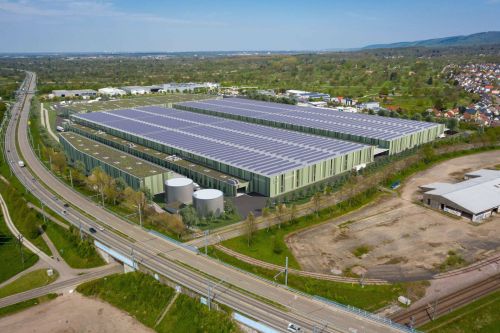Cities fit for living in
Architecture
Why should this be? The idea behind woonerfs [pronounced ‘vonherf’] involves a significant reduction in car traffic and giving the right of way for the urban space over to pedestrians. The consent of local authorities and motorists for such schemes can, therefore, be very difficult to obtain. For many it is a concept alien to Polish traditions for designing urban space – and many people are sceptical about the benefits of it. As a result, the number of such projects carried out so far in Poland is less than impressive. “In my opinion, the reason why this kind of scheme has failed to take off stems from the Polish mentality. Poles love cars and convenience. The majority of us would like to travel fast. So the woonerf concept might initially seem to be very unattractive, even though parking spaces are usually created within their limits. However, from what I have seen, wherever the development of woonerfs was a conscious and well thought-out move, the satisfaction of residents and external users has been immense,” remarks Grzegorz A. Buczek, an architect, urban planner and lecturer at the Warsaw University of Technology.
Things get better
The first Polish woonerf – or urban courtyard, according to Hubert Barański, the chairman of Fenomen – Fundacje Normalne Miasto [the Normal City Foundation] in Łódź – was first created in Poland on ul. 6 Sierpnia in Łódź in 2014. “Now there are about ten woonerfs in Łódź, of various sizes and quality. Apart from ul. 6 Sierpnia, the city’s classic woonerfs also include ul. Traugutta and ul. Piramowicza. Others are estate woonerfs,” explains Hubert Barański. He also claims that such areas do not exist anywhere else in Poland outside Łódź. “Advanced work on the construction of such schemes is in progress in such places as Lublin, Gdynia, Wadowice and Wrocław. Warsaw councillors have also visited Łódź to see how the streets function, but woonerfs have yet to be created in the capital city,” he adds. However, work on such projects is underway. Warsaw city council is planning to redevelop ul. Środkowa in Praga Północ district as part of its Integrated Revitalisation Programme. The city hall has announced an architectural competition for the development of this area (including ul. Strzelecka). The deadline for the submission of competition entries was in mid-September. “Under the Integrated Revitalisation Programme we are aiming to introduce a new quality of public space to Praga Północ. Ul. Środkowa will in particular undergo a metamorphosis, as we want to transform it into a woonerf – an area that combines the functions of promenade, street, car park and meeting place,” explained Michał Olszewski, one of the deputy mayors of Warsaw, at the unveiling of the plans. Plans have also been announced to revitalise ul. Narbutta (in its section between al. Niepodległości and ul. Puławska) in the city’s Stary Mokotów district. A community page dedicated to the idea has even been set up on Facebook to promote the scheme. “According to my information, outside Łódź it is the work on the woonerfs in Lublin and Wadowice that is the most advanced,” claims Hubert Barański. Wadowice council’s plan is for the redevelopment of ul. Lwowska in the town. The building permit application for the project is currently in progress. A total of 25 new trees and 16 benches are to be added to the section of road. Car traffic will not be prohibited completely, but it will have to drive much slower. The traffic route is to be given an s-shape typical for a woonerf. Local media has reported that the introduction of a woonerf on ul. Lwowska is to cost app. PLN 3 mln. In Lublin, meanwhile, the idea has been mooted of transforming ul. Zielona into a woonerf. In its preparations for the project, the city council has established a ‘living zone’ in the area. This is an important step – the functioning of a woonerf in Poland is based on guidelines enforced by D-40 signs (demarcating a living zone). In areas marked by the sign, pedestrians have the right to walk on the road with absolute priority. Drivers, however, have to limit their speed to 20 km per hour and can only park in specially designated areas.
Vox populi
The majority of projects to transform streets into woonerfs originate in civic initiatives. This has been the case in Łódź as it was in many cities. “The woonerfs in Łódź were created based on our own initiative. Architect Bartosz Zimny came to the Foundation and submitted his concept for an urban courtyard. He drew it up and we started to look at the urban infrastructure from the angle of its possibilities. In the city centre alone we selected a few hundred streets that subsequently qualified under the various criteria,” explains Hubert Barański. And he also provides an explanation as for why these projects interest the local community more than the city authorities. “In Poland we still have a 70s-type approach, which mostly involves convenience for car owners. Decision-makers fear that they will be eaten alive by their electorate who, they seem to believe, all drive cars,” says Hubert Barański, with some irony. It certainly seems to be the case that when it comes to woonerfs you tend to hear about grassroots local movements pushing for their creation, rather than them springing from municipal schemes. “In Wrocław we believe that restricting the local traffic, re-ordering the parking facilities and increasing the amount of greenery, such as happens in the development of woonerfs, should be a local community grassroots initiative. That is why we are now planning to carry out such projects mostly using funds from the city budget. We can see that such projects are enjoying growing interest; however, we they are not top-down planned. Out of the projects submitted this year, the one for ul. Ruska deserves a notable mention,” emphasises Tomasz Stefanicki, Wrocław city council’s pedestrian officer.
Projects submitted by citizens also include ul. Krupnicza in Kraków. This scheme was a candidate in a participatory vote for the allocation of the city budget for public projects – it came sixth. The project for the transformation of ul. Abrahama (a section between ul. 10 Lutego and ul. Batorego) in Gdynia fared better – its residents decided that they wanted to carry out the project funded by the city. Meanwhile, there is also the woonerf initiative of the Rzeszów Smart City movement on ul. 3 Maja in the city. Wrocław city council is also looking into woonerfs as an option and can see such a possibility on ul. św. Antoniego. “Our idea involves slowing down the traffic, moving the parking away from the streets – large multi-storey car parks have since been built in the area – along with the introduction of greenery and such outdoor fixtures as bicycle racks, litter bins and benches as well educational ones – cubes featuring the images of tenement buildings in the city from a hundred or more years ago,” reveals Wrocław city council project manager Mariola Apanel. The concept, which has been given the approval of the deputy mayor of Wrocław, was prepared by two organisations: Towarzystwo Upiększania Miasta Wrocławia, which is made up of enthusiasts of the history and architecture of Wrocław, as well as the Akcja Miasto association. “Interestingly, the residents of this street were sceptical about the idea; however, they later came round to it and can now enjoy it – as those living on neighbouring streets can only look on with envy. The residents were even curious about the shop the plant pots were ordered from as they wanted to put the same ones in front of their flats near their doors,” emphasises Mariola Apanel.
Woonerf deluxe
Benches, greenery, sculptures and summer gardens alongside restaurants and bars – this is the deluxe version of the woonerf. The classic model only involves slowing down the traffic and giving the space over to pedestrians. All other features are a bonus. “You can definitely say that the woonerfs in Łódź are unique. The one on ul. 6 Sierpnia is like it is for a number of reasons: it has a granite surface, several-year-old graft cherry trees imported from Austria, a sculpture (a column with a city clock) as well as a number of other outdoor fixtures. On ul. Piramowicza an old-style ornamental water pump has been installed, while on ul. Traugutta a futuristic children’s playground has been created, which has been very successful. However, this does not mean that each woonerf has to look like that,” explains Hubert Barański. Nonetheless, it is true that woonerfs do tend to win over the residents – even those who had been initially unsure about the project. They are usually regarded as a good step and much appreciated after their completion. “The woonerf concept is very popular in Łódź. Residents even held a party to celebrate the name day for ul. 6 Sierpnia [Polish for August 6th]. They have also started a conversation over the appearance of their tenement buildings and a local community association has been formed. Furthermore, the owners and administrators of the buildings have been encouraged to renovate the façades of their properties. Some people came up with the idea of having the same signs and flowers on their balconies and beautifying their urban space. This has turned out to be one of the best examples of urban revitalisations,” effuses Hubert Barański. And what are the construction costs for a woonerf? This is a tricky question to answer, as everything depends on the street itself – its length, the quality of the surface and the situation on the construction product market. The woonerfs in Łódź each cost in the range of PLN 1.3–1.5 mln.
Hubert Barański points out an important aspect of woonerfs – the revival of the local community. And Grzegorz A. Buczek also indicates other benefits. “The development of woonerfs is, in my opinion, one of the ways of improving the quality of life in a city, increasing its safety as well as the social contact between people. This is pure synergy: if the public area is well arranged and safe to be in, people feel good and they tend to stay there more, while the services on its edges then become more attractive and the value of the properties located in such places automatically increases. There are many examples abroad that show how streets that used to be dead have been turned into showcases for their city. Because of the streets’ added functions, such as turning them into meeting places, there are more and more shops and services on them. This is why the idea of high streets and shopping streets is going undergoing a revival,” believes Grzegorz A. Buczek. However, the urban planner does admit that woonerfs have to be designed with some care and forethought in order to adequately do their job. “One condition that needs to be fulfilled for a woonerf to function properly is that the street or part of the city has to be selected in a highly considered way and designed appropriately. This reduces any of the possible inconveniences resulting from the return of social life to the streets. Because it has to borne in mind that the buildings along the woonerf are still essentially residential. The development of such places does not make sense if it is forced through regardless of the residents’ concerns, because a woonerf breaks a private zone and opens up a fragment of the city to people from the outside,” explains Grzegorz A. Buczek.





















































